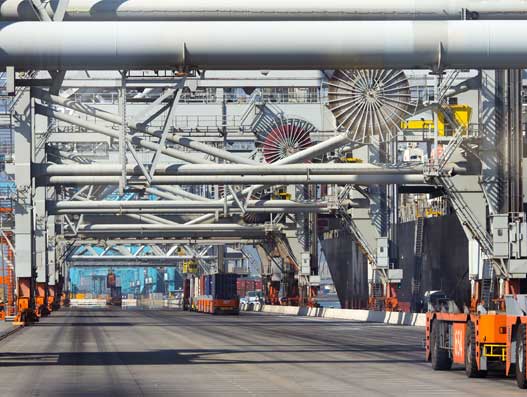
Automated future for ports
Just twenty years ago, terminals were planning vessels with stickers and physically monitoring terminal activities and container movements. With this industry currently demanding more efficient terminals, automation is becoming the norm. Surya Kannoth Ports have to become more efficient to lower costs and increase performance for shipping companies. To achieve this, there is a growing need […]

Just twenty years ago, terminals were planning vessels with stickers and physically monitoring terminal activities and container movements. With this industry currently demanding more efficient terminals, automation is becoming the norm.
Surya Kannoth
Ports have to become more efficient to lower costs and increase performance for shipping companies. To achieve this, there is a growing need for operators to invest in capabilities that reduce turnaround and waiting times for ships, and cut cargo holding times.
Globally, it has been witnessed that port improvements can increase productivity and unleash efficiencies. Take for example, the highly automated ports in Hong Kong, Singapore and Taiwan can undertake 46 crane moves per hour. This makes them 13 percent more efficient than ports in the Middle East and 43 percent more efficient than North American ports in unloading cargo.
Further, Singapore’s port has an average ship turnaround time of 12 hours (with a best of six hours)—which is 150 percent better than the global average, and twice as efficient as Shanghai. Singapore consistently achieves higher customer satisfaction than other ports in the region. Port operators need to follow the lead of these markets, and innovate and re-engineer their businesses, creating lower-cost enterprises that can deliver more attractive offerings for shipping lines.
Port operators can now ‘buy’ productivity increases by automating their operations. Ports in Indonesia, Vietnam and Malaysia are using automation to quickly boost productivity in ways that weren’t possible for older operators. “In our experience, automation technology can deliver a 30 percent boost in productivity. To stay ahead of the curve,
leading port operators should continually update their use of automation to further raise the bar on productivity improvements,” said an Accenture report.
Current trends in automation are focused on automating both equipment handling and operational processes for ports and terminal operators. As far as equipment is concerned, there are solutions for yard cranes and horizontal transportation vehicles. For quay cranes, revolutionary new functionality has been developed for remote operations that are currently going live in Jebel Ali and Rotterdam.
“Automation not only means “kinematics.” Automation means a new way to manage container terminals, addressing many different levels of the business, explains Dr Oscar Pernia, senior director, product strategy, Navis. Navis provides the global technology standard for managing the movement of cargo through terminals. Navis N4 terminal operating system (TOS) is used at more than 100 sites, in more than 50 countries around the world. It has been developed as a platform that offers scalability and flexibility to support a terminal’s growth and to add features, functionality and be easy to plug third party solutions into. “We have about two new releases of the N4 platform annually. The next release, scheduled for next year, will support a wider-range of terminal operational needs including fully automated, semi-automated or manual operations,” he says.
In general, automated equipment handling is getting more mature with market competition helping to push the boundaries with automated features for safety, performance and control. As a result, there is more of a focus on decision support software tools that can improve equipment scheduling and dispatching efficiency. These tools help to maximize equipment productivity and utilization while reducing the associated operational costs.
“Just twenty years ago, terminals were planning vessels with stickers and physically monitoring terminal activities and container movements. As the terminal operations industry faces new operating demands, new tools, new equipment, and new software have been developed and are now available. Since this industry is demanding more efficient terminals, automation is becoming the norm,” believes Dr Pernia.
So how does automation help ease operations for terminals? Explains Dr Pernia, “Automation can help improve the efficiency of the movement of cargo into and out of a terminal. By changing processes from manual to automated, automation can speed up and reduce errors in the processing of the cargo and containers. It addition, it can help with a terminal’s sustainability initiatives with reduced fuel costs and emissions, while improving safety.”
“Through the automatic identification of containers, equipment positions and staff, logistical flows become less error sensitive and thereby more efficient and productive. Errors are detected by systems and can be resolved in a remote, centralized manner,” says Dave Walraven of Netherlands-based Certus Automation. CERTUS has the most dense installed base in its home town: Port of Rotterdam as well as in the port of Antwerp.
Furthermore, automated operations should provide consistency and enhance an operation. A fully automated terminal should deliver better operating performance than a non-automated terminal. State of the art equipment, technology and software are able to provide simple,
reliable and efficient operations getting success in very complex and exigent scenarios.
Gate OCR portals are transforming to data capture portals thus being able to provide additional details like truck weight and damage conditions. The portals are no longer limited to only imaging technology and can be delivered as a complete solution that also supports other technologies for data capturing.
Also, Position Detection Systems (PDS), Optical Character Recognition (OCR) and Radio Frequency Identification (RFID) have been successfully applied to automate many manual processes involved in cargo and container handling. The recent trend is to focus on data availability and accuracy generated from these systems and delivered to a central software platform (terminal operating system- TOS). The TOS can then provide operational control and traceability with business intelligence and analytics.


